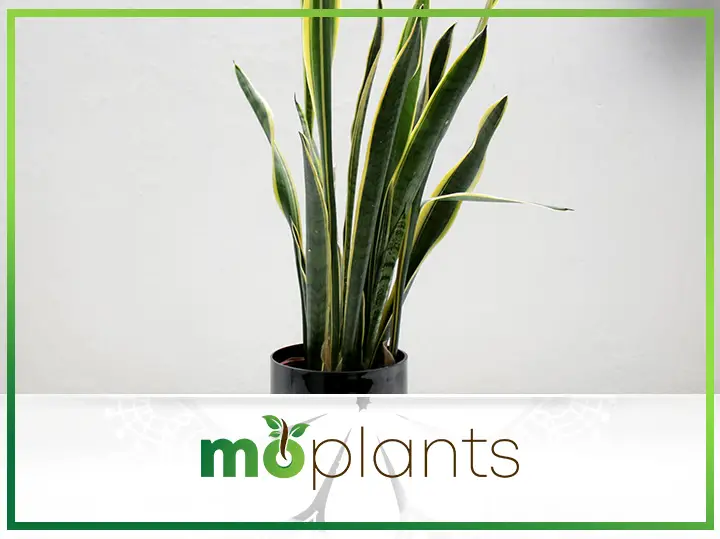If you are a beginner who has never taken care of a plant before or are looking for a succulent that can pretty much grow on its own, the chic snake plant can be the perfect companion for you.
The glossy and striped sword-shaped leaves of this popular houseplant can add a pop of color and texture to an otherwise dull and dreary corner. It is also tough to kill a snake plant because it is virtually indestructible. Even if you forget to water or feed this plant for a month or so, it will continue to thrive. In simple words, it is one of the most forgiving and easiest plants to grow and take care of.
Though it is native to tropical West Africa, the snake plant is loved and adored worldwide. Its leaves have green bands adorned with yellow margins resembling snakeskin, which has inspired its unique name. Interestingly, it has several other aliases that are just as attention-grabbing. The most common ones include Mother-in-Law’s Tongue and St. George’s Sword. Snake plant is also known as the Tiger’s Tail Orchid in China, Tiger’s Tail in Japan, and Pike’s Tail in Russia. Another exceptional name of this plant is Viper’s Bowstring Hemp, as its fibers are strong enough to make strings for bows.
The hard-to-kill nature and striking appearance are not the only reasons, so many homeowners favor snake plants. As it turns out, this houseplant can also clean the air and get rid of airborne allergens to ensure a healthier and fresher indoor environment. Moreover, it stores up oxygen during the daytime and releases it at night, making it an ideal plant to place on your bedside table.
Introduction: Snake Plant
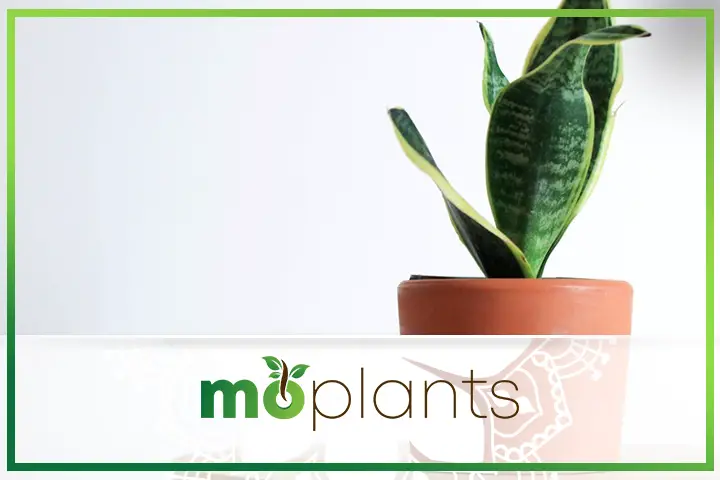
The botanical name of the snake plant is Dracaena trifasciata, and it belongs to the Asparagaceae family. Until 2017, it was classified as Sansevieria trifasciata, which is why most people still call it “Sansevieria.”
Snake plants are known for their upright and narrow variegated leaves ranging from 6 inches to 8 feet in length. Most varieties of this plant have dark green striped leaves with a yellow border, though you may also find snake plants with different colored streaks. They have thick roots and grow at a relatively slow pace when placed indoors.
Snake plants can produce small flowers that look like honeysuckle with green, cream, or white hues in their natural habitat. These flowers have a rich fragrance and contain sweet and sticky nectar. Moreover, the flower stalk is usually as long as three feet. The plant only blooms once a year, usually during the spring season. However, you are not likely to witness this rare occasion when growing a snake plant indoors.
The easygoing nature of the snake plant is perhaps its biggest asset. It doesn’t require much natural light and can tolerate even the most unsuitable growing conditions. So, if you live in an apartment that doesn’t have enough open space to grow plants, snake plants can be an excellent option for you. Meanwhile, if you want to grow this green beauty in your garden or backyard, make sure to choose a shaded spot as bright light can boost its growth, but direct sunrays will burn its leaves.
The aesthetic beauty of the snake plant is yet another factor why it is so popular among interior designers. You can display this statement plant in your bedroom, living room, bathroom, kitchen, hallways, or any other part of the house to make instantly elevate your décor and make it look more stylish.
It can also absorb carbon dioxide, benzene, formaldehyde, toluene, and xylene, among other toxins, from its surroundings. Therefore, sleeping next to a snake plant or keeping it in the bedroom can help improve your health.
How to Grow Snake Plant
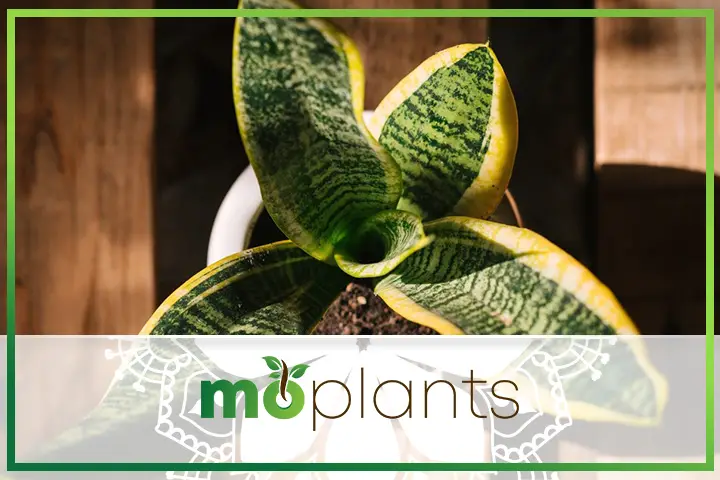
When you visit your local nursery to buy a snake plant, make sure to choose one that has rich green and unbroken leaves. If you are thinking about growing this plant from seeds, please note that many snake plant seeds don’t germinate, so it’s better to purchase a young plant and eventually propagate it to create new ones.
Here are some tips on how to grow snake plants that all amateur gardeners will find helpful.
Placement
Snake plants can survive in any corner of your house. But if you want the leaves to look fresh and glossy at all times, place the plant near a window that receives a lot of bright but indirect light. Since the leaves of snake plants extend upward, you should place them in a spot where they’ll have enough room to grow.
Ideal Temperature
Being native to West Africa, snake plants prefer warm and humid conditions. Generally, this plant thrives in temperatures between 70 and 90 degrees Fahrenheit. If you have placed your plant outdoors, make sure to bring it inside once the temperature drops below 50 degrees. It is also worth mentioning that frost can kill your snake plant, so you must protect it from cold drafts.
Humidity Level
As mentioned above, snake plants flourish in humid environments. You can even place them at a bright spot in your bathroom to give your space a spa-like appearance.
Exposure to Sunlight
Snake plants prefer bright and steady light, though they are not fond of receiving direct sunlight. That being said, this houseplant can adapt to almost any situation. Even if you don’t have many bright spots in your home, you can grow snake plant indoors by placing them near a window.
Watering Frequency
Your snake plant may be able to tolerate neglect, but it surely won’t survive overwatering if you don’t want your plant to suffer; only water it every ten days.
The best way to determine if your snake plant needs water is to stick your fingers in the soil. If it feels dry, it’s time to water the plant. However, if you feel any moisture, hold off on watering for another day or two.
Moreover, it would be best to water your snake plant less often in winter compared to the summer and spring seasons. If possible, water from the bottom of the pot so the roots are encouraged to grow in a downward direction.
Potting Mix
A well-drained potting mix is ideal to grow snake plant indoors. Choose a potting media that is sandier and low in peat. If you have difficulty finding a suitable option, visit your local nursery and ask for an all-purpose cactus potting soil.
Snake Plant Propagation Method
There are three important snake plant propagation techniques that you must know about.
Propagating Through Root Division
Once the leaves grow about four-inch-tall, gently pull out the root ball and divide it into sections using a sharp knife. Please make sure the roots for each section remain intact as you plant them into separate containers. Fill the new pots with fresh potting soil and add some water. You can keep the new plants in a sunny location until the roots begin to grow.
Propagating New Offshoots
If your plant has developed any offshoots, you can separate them using a clean and sharp knife from the mother plant. To do so, you’ll have to pull out the root ball and cut off the offshoot’s root. Then plant it in a new pot with fresh soil and place it in a bright spot. Also, don’t forget to water it.
Propagating Through Leaves
If the leaves of your snake plant have become several inches tall, you can slice off a long and healthy leaf with a pair of sterilized scissors and place it in a glass jar full of clean water. Make sure the cut end is submerged in water.
You can keep your jar in a partially sunny spot near a window and keep an eye out for any root growth. It is essential to top off the water every couple of days and change it every two weeks to prevent bacterial growth. Once the roots begin to develop, wait for them to get an inch long before planting the leaf into a fresh pot with new potting soil.
The best time for snake plant propagation is spring. Moreover, since it isn’t a particularly fast grower, you probably won’t notice any substantial growth during the first two months.
Infographic
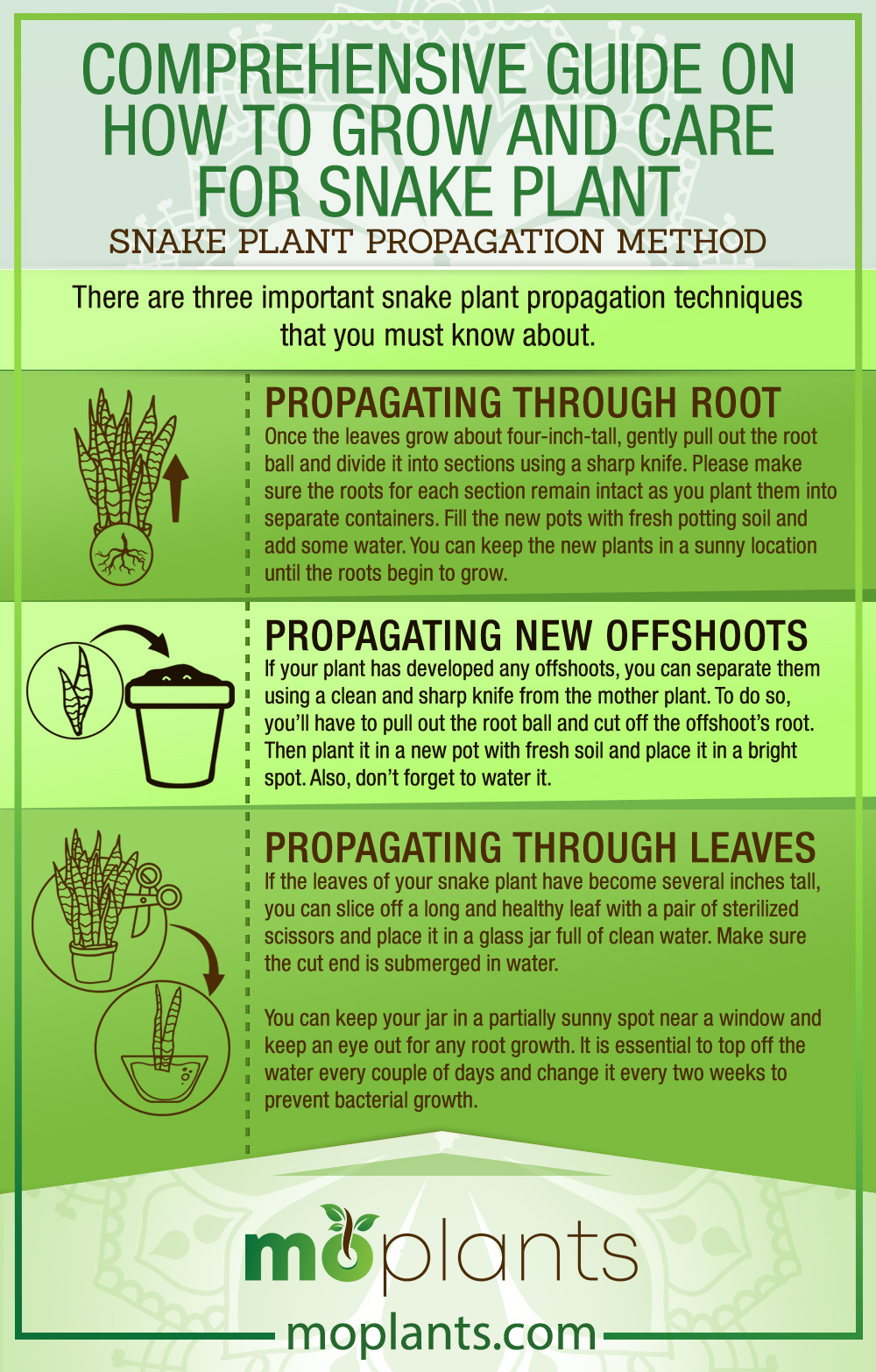
Snake Plant Care Tips

The snake plant doesn’t require any special treatment. However, if you want it to remain healthy and happy, here are some snake plant care tips that you may want to follow:
Pruning and Trimming
Removing damaged and mature leaves can keep your plant alive for a long time. However, you must only prune your snake plant during the summer or spring season, as it is the growing period. In addition, you should always use clean pruning shears or a sharp knife to cut off any marred or old leaves to spur new growth.
It is also important to remember that pruning during the off-season can stress out your snake plant. Therefore, it may not be a good idea to cut off any leaves during the winter season unless they are damaged. You can also remove the tallest leaves from your snake plant to control its height.
Balanced Fertilizer
Feeding your snake plant once a month is enough to keep it alive. This houseplant prefers a balanced liquid fertilizer. In addition, like most plants, you should only fertilize your snake plant during the growing season.
Wiping and Cleaning
Keep your snake plant dust-free by wiping it with a clean cloth every few days. You can also wash the leaves with plain water if they appear particularly grimy. A clean surface will allow the leaves to absorb pollutants and release oxygen more effectively.
Repotting
Snake plants grow at a slow pace when placed indoors. However, if you place them outdoors or in a bright spot, they may grow faster. In either case, you should remove the root ball and place it in a bigger container as soon as you notice the roots emerging from the drainage hole in your pot.
Furthermore, always select a sturdy container for your snake plant as its strong roots can easily break weaker pots. Generally, terracotta pots are an excellent option for this wonderful houseplant.
Another snake plant care tip is only to report this green beauty during the spring season.
Common Snake Plant Problems and How to Solve Them
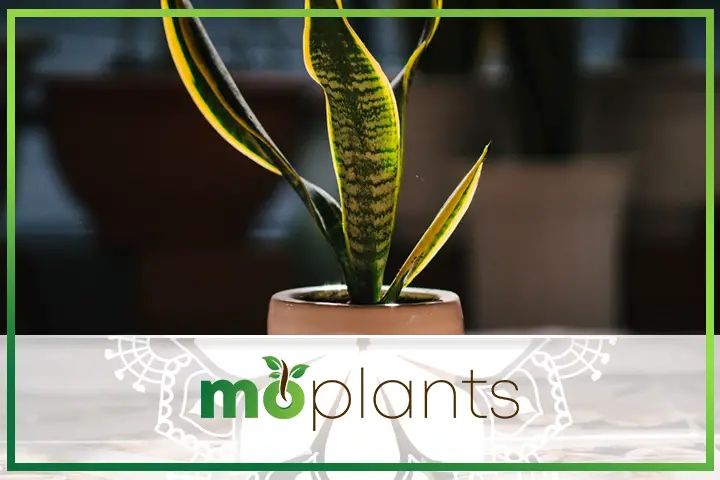
These are some of the common problems you may experience while taking care of your snake plant.
Root Rot
If the potting soil of your snake plant smells foul or rotten, it may be a sign of root rot. To test the unpleasant odour coming from the plant, scoop out some potting soil and hold it close to your nose. It may not be easy to salvage a plant after the rot has set in in some cases. However, you can try to restore your snake plant to its former glory by pulling the root ball out of the container and cutting away any damaged roots and leaves.
You can plant the healthy section of the root ball into a new container and fill it with a well-draining potting mix. Additionally, you must always choose pots with an adequate drainage hole.
Yellow or Brown Leaves
If the leaves of your snake plant are turning yellow or brown, it may indicate a few different things, such as overwatering, pest infestation, and root rot.
Therefore, the first thing you must do is move your plant to a bright spot in your home and reduce the watering frequency. Next, if you can see any pests on the leaves of your beloved plant, wipe them away using neem oil or a mild insecticidal soap. You may have to trim the root ball and plant it into a new container in case of root rot.
Curling Leaves
Snake plants have long, stiff leaves that shoot upward. However, if you have noticed the leaves curling, they may be infested with thrips, which are tiny black bugs. The easiest way to deal with these pests is to cut away the curled leaves and spray the plant with a mild insecticide.
Falling or Drooping Leaves
Dim lighting, lack of fertilizer, and soggy soil are among the most common culprits behind soft and droopy leaves. You should move your plant to a brighter and warmer location to make sure the soil dries up quickly, and the plant receives sufficient light. Adding fertilizer might also help.
Common Pests and Diseases
Your snake plant may also be susceptible to fungus gnats, aphids, spider mites, scales, mealybugs, and whiteflies, among other pests. If you notice any insects on your plant, use an organic insecticide to keep your plant healthy and fresh.
Infographic

Is Snake Plant Toxic?
Yes, almost all snake plant varieties are toxic to cats and dogs. If your pet chews or ingests the leaves, it may result in vomiting and diarrhea. You should also keep your young ones away from this houseplant.
Snake Plant Varieties
These are some of the most common snake plant varieties that can freshen up any room in your house.
Bird’s Nest Snake Plant
It is a compact houseplant that only grows to about six inches tall. The cluster of leaves forms a shape similar to a cup or a bird’s nest, thus inspiring its name. You can easily keep this plant on your bedside table or coffee table.
Cylinder Snake Plant
This type of snake plant has thick round leaves. They grow several feet in length, arching outward from a central crest. This plant looks almost regal and can be a great fit for your living room or dining room.
Laurentii Sansevieria
It is yet another well-known variety of snake plants. Laurentii Sansevieria has green leaves with creamy yellow margins. If you want to propagate this plant, you will have to divide the root ball of the mother plant, as the leaf-cut propagation method may not work.
Variegated Snake Plant
This type of snake plant can grow up to several feet tall and is tolerant of low lights and dark corners. The variegated snake plant has a dramatic appearance as its long leaves are about two to four inches wide.
Snake Plant FAQs
Here are some of the most commonly asked questions about snake plants.
How long does a snake plant live?
The average lifespan of a snake plant is between five to ten years when grown indoors. However, in their native habitat, they can live for up to 25 years.
What is the average height of snake plants?
The height of your snake plant largely depends on its variety, placement, and fertilizer. Usually, these plants can grow up to five feet tall in an average home environment.
How long can snake plants go without water?
Snake plants are relatively low-maintenance and can go up to two weeks without water during the summer season. In winters, they can live without fresh water for nearly a month.
How to know if your snake plant is healthy?
If your snake plant has straight, shiny, and fleshy green leaves, it is perfectly healthy. However, if the leaves appear droopy, wrinkly, or brown, it coulds indicate root rot or pest infestation.
There you have it – a complete guide on how to grow snake plant indoors.

